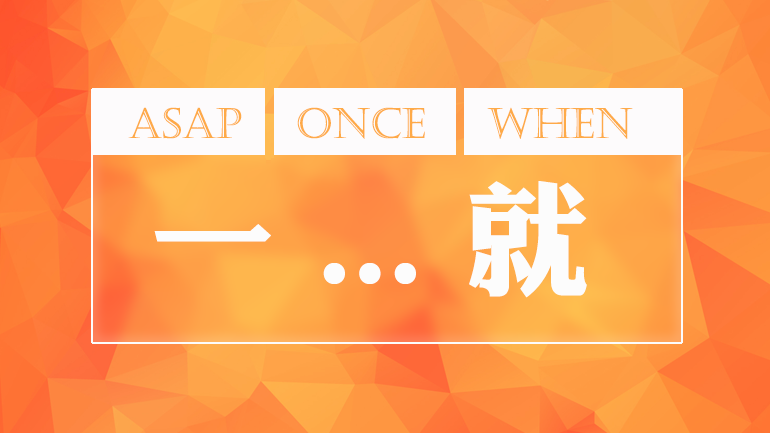
The 一 … 就 pattern (yī … jiù) is very common in Chinese grammar. It's used to say things like "as soon as", "once" and "whenever", so it's a very useful and important structure to know.
“一……就”是汉语中很常见的语法结构。意思类似英文中的“as soon as”、“once”和 “whenever”。由此可以看出该结构非常重要且实用,需详细掌握。
The basic structure is:
“一……就”的用法:
[subject] 一 [action] 就 [another action]
主语+一+动作+就+另一动作
This is equivalent to saying "As soon as [subject] does [action], they do [another action]"or "whenever [subject] does [action], they do [another action]".
和英文当中的“As soon as [主语] does [动作], they do [另一动作]”结构以及“whenever [主语] does [动作], they do [另一动作]“结构是一致的。
You can also use this structure with two different subjects. In that case, the second subject just goes before 就. This will seem natural once you see it in the example sentences below.
这个结构也可以有两个不同的主语。这时,第二个主语应该放在“就”之前。你看完以下例句之后就会明白了。
Let's have a look at the slightly different meanings this structure can have one by one.
让我们逐一来看一下这个结构的不同意思之间的细微差别。
一 … 就: "as soon as"
Perhaps the most common use of the 一 … 就 pattern is to say "as soon as". You just put the first event or action after 一, and the following event or action after 就.
“一 …… 就”最常见的英文翻译大概就是“as soon as”了。第一件事或动作放在“一”后,接下来的事情或动作放在“就”后。
Have a look at some example sentences:
请看例句:
我一到上海就打电话给你。
Wǒ yī dào Shànghǎi jiù dǎ diànhuà gěi nǐ.
I'll phone you as soon as I arrive in Shanghai.
小偷一看到警车就跑走了。
Xiǎotōu yī kàn dào jǐngchē jiù pǎo zǒu le.
The thief ran off as soon as he saw the police car.
他一放学就回宿舍了。
Tā yī fàngxué jiù huí sùshè le.
He went back to the dorm as soon as he finished class.
Notice how the actions are put into the same slots in each of the sentences: 一 [first action] 就 [second action].
请注意每一个例句中动作的位置:一+第一个动作+就+第二个动作
一 … 就: "once" or "when"
Using 一 … 就 to mean "once" or "when" is actually very similar to using it to mean "as soon as". It's just an alternative translation in English. The meaning is the same. In all cases, this pattern is about doing one thing immediately after another.
“一 …… 就”表示once 或 when时和表示as soon as时的意思是相同的。Once, when以及 as soon as只是为了符合英文当中的词语的多样性,但意思是一样的。在任何情况下,该结构都是表示某事立刻发生在另一件事情之后。
Some examples:
例句:
我工作一做完就来找你们。
Wǒ gōngzuò yī zuò wán jiù lái zhǎo nǐmen.
I'll come and find you once I've finished my work.
太阳一出来,雪就会融化。
Tàiyáng yī chūlái, xuě jiù huì rónghuà.
The snow will melt when the sun comes out.
她一戴上安全帽就感觉安全多了。
Tā yī dàishàng ānquán mào jiù gǎnjué ānquán duō le.
She felt much safer once she'd put her helmet on.
In all of the above example sentences, "as soon as", "once" and "when" are pretty much interchangeable as translations.
在以上所有的例句当中,“一 …… 就”可以翻译成as soon as, once 和when。
一 … 就: "whenever"
Finally, this pattern can also be used to express "whenever". This is used to talk about habitual actions that happen whenever some other event or action happens.
最后,这个结构也可以用来表示任何时候。在这种情况下,此结构用于描述某件事在任何情况下发生后的习惯性动作。
Let's have a look at some example sentences:
请看例句:
我一有问题就用谷歌查一下。
Wǒ yī yǒu wèntí jiù yòng Gǔgē chá yīxià.
Whenever I have a question, I just Google it.
我一得到一大笔钱就捐一部分给慈善机构。
Wǒ yī dédào yī dà bǐ qián jiù juān yī bùfèn gěi císhàn jīgòu.
Whenever I get a large sum of money, I donate some of it to charity.
那两个人一遇到对方就开始吵架。
Nà liǎng gèrén yī yù dào bǐcǐ jiù kāishǐ chǎojià.
Those two people start arguing whenever they meet.
Hopefully you can see the common theme for using 一 … 就. It's always about things that happen right after or because of other events.
希望通过本篇文章,你能领会“一……就”结构的准确用法。若某件事情发生在某事之后或由某事引起,则通常用这个结构。



 闽公网安备 35020302035673号
闽公网安备 35020302035673号
0 responses on "How to use Chinese grammar structure "一 … 就""